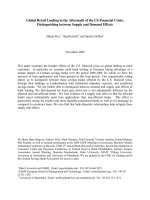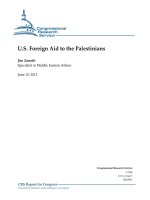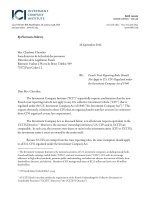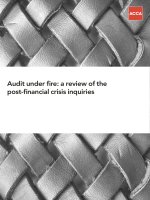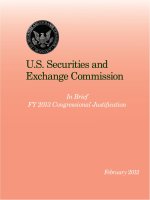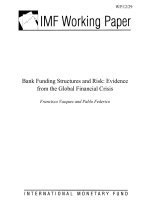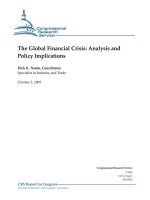powell (ed.) - u.s. insurance industries after the 2007-2009 financial crisis (2013)
Bạn đang xem bản rút gọn của tài liệu. Xem và tải ngay bản đầy đủ của tài liệu tại đây (1.62 MB, 122 trang )
BUSINESS ECONOMICS IN A RAPIDLY-CHANGING WORLD
U.S. INSURANCE INDUSTRIES
AFTER THE
2007-2009
FINANCIAL CRISIS
No part of this digital document may be reproduced, stored in a retrieval system or transmitted in any form or
by any means. The publisher has taken reasonable care in the preparation of this digital document, but makes no
expressed or implied warranty of any kind and assumes no responsibility for any errors or omissions. No
liability is assumed for incidental or consequential damages in connection with or arising out of information
contained herein. This digital document is sold with the clear understanding that the publisher is not engaged in
rendering legal, medical or any other professional services.
BUSINESS ECONOMICS IN A
R
APIDLY-CHANGING WORLD
Additional books in this series can be found on Nova’s website
under the Series tab.
Additional E-books in this series can be found on Nova’s website
under the E-book tab.
GLOBAL RECESSION - CAUSES,
IMPACTS AND REMEDIES
Additional books in this series can be found on Nova’s website
under the Series tab.
Additional E-books in this series can be found on Nova’s website
under the E-book tab.
BUSINESS ECONOMICS IN A RAPIDLY-CHANGING WORLD
U.S. INSURANCE INDUSTRIES
AFTER THE
2007-2009
FINANCIAL CRISIS
JOHNSON B. POWELL
EDITOR
New York
Copyright © 2013 by Nova Science Publishers, Inc.
All rights reserved. No part of this book may be reproduced, stored in a retrieval system or
transmitted in any form or by any means: electronic, electrostatic, magnetic, tape,
mechanical photocopying, recording or otherwise without the written permission of the
Publisher.
For permission to use material from this book please contact us:
Telephone 631-231-7269; Fax 631-231-8175
Web Site:
NOTICE TO THE READER
The Publisher has taken reasonable care in the preparation of this book, but makes no
expressed or implied warranty of any kind and assumes no responsibility for any errors or
omissions. No liability is assumed for incidental or consequential damages in connection
with or arising out of information contained in this book. The Publisher shall not be liable
for any special, consequential, or exemplary damages resulting, in whole or in part, from
the readers’ use of, or reliance upon, this material. Any parts of this book based on
government reports are so indicated and copyright is claimed for those parts to the extent
applicable to compilations of such works.
Independent verification should be sought for any data, advice or recommendations
contained in this book. In addition, no responsibility is assumed by the publisher for any
injury and/or damage to persons or property arising from any methods, products,
instructions, ideas or otherwise contained in this publication.
This publication is designed to provide accurate and authoritative information with regard
to the subject matter covered herein. It is sold with the clear understanding that the
Publisher is not engaged in rendering legal or any other professional services. If legal or any
other expert assistance is required, the services of a competent person should be sought.
FROM A DECLARATION OF PARTICIPANTS JOINTLY ADOPTED BY A
COMMITTEE OF THE AMERICAN BAR ASSOCIATION AND A COMMITTEE OF
PUBLISHERS.
Additional color graphics may be available in the e-book version of this book.
Library of Congress Cataloging-in-Publication Data
Published by Nova Science Publishers, Inc. † New York
ISBN: (eBook)
CONTENTS
Preface vii
Chapter 1 Insurance Markets: Impacts of and Regulatory
Response to the 2007-2009 Financial Crisis 1
United States Government Accountability Office
Chapter 2 Government Assistance for AIG: Summary and Cost 81
Baird Webel
Index 105
PREFACE
The U.S. life and property/casualty (P/C) insurance industries wrote over
$1 trillion in total premiums in 2011 and play an important role in ensuring the
smooth functioning of the economy. Concerns about the oversight of the
insurance industry arose during the 2007-2009 financial crisis, when one of the
largest U.S. holding companies that had substantial insurance operations,
American International Group, Inc. (AIG), suffered large losses. These losses
were driven in large part by activities conducted by a non-insurance affiliate,
AIG Financial Products, but also included securities lending activity
undertaken by some of its life insurance companies which created liquidity
issues for some insurers. The losses threatened to bankrupt the company, and
AIG was one of the largest recipients of assistance by the Federal Reserve
Bank of New York and the federal government under the Troubled Asset
Relief Program (TARP) set up during the crisis. This book examines any
effects of the financial crisis on the insurance industry and policyholders, and
addresses what is known about how the financial crisis affected the insurance
industry and policyholders, and the types of actions that have been taken since
the crisis to help prevent or mitigate potential negative effects of future
economic downturns on insurance companies and their policyholders.
Chapter 1 - Insurance plays an important role in ensuring the smooth
functioning of the economy. Concerns about the oversight of the $1 trillion life
and property/casualty insurance industry arose during the 2007-2009 financial
crisis, when one of the largest holding companies, AIG, suffered severe losses
that threatened to affect its insurance subsidiaries. GAO was asked to examine
any effects of the financial crisis on the insurance industry.
This report addresses (1) what is known about how the financial crisis of
2007-2009 affected the insurance industry and policyholders, (2) the factors
Johnson B. Powell
viii
that affected the impact of the crisis on insurers and policyholders, and (3) the
types of actions that have been taken since the crisis to help prevent or
mitigate potential negative effects of future economic downturns on insurance
companies and their policyholders.
To do this work, GAO analyzed insurance industry financial data from
2002 through 2011 and interviewed a range of industry observers, participants,
and regulators.
Chapter 2 - American International Group (AIG), one of the world’s major
insurers, was the largest direct recipient of government financial assistance
during the recent financial crisis. At the maximum, the Federal Reserve (Fed)
and the Treasury committed approximately $182.3 billion in specific
extraordinary assistance for AIG and another $15.9 billion through a more
widely available lending facility. The amount actually disbursed to assist AIG
reached a maximum of $184.6 billion in April 2009. In return, AIG paid
interest and dividends on the funding and the U.S. Treasury ultimately
received a 92% ownership share in the company. As of December 14, 2012,
the government assistance for AIG ended. All Federal Reserve loans have
been repaid and the Treasury has sold all of the common equity that resulted
from the assistance.
Going into the financial crisis, the overarching AIG holding company was
regulated by the Office of Thrift Supervision (OTS), but most of its U.S.
operating subsidiaries were regulated by various states. Because AIG was
primarily an insurer, it was largely outside of the normal Federal Reserve
facilities that lend to thrifts facing liquidity difficulties and it was also outside
of the normal Federal Deposit Insurance Corporation (FDIC) receivership
provisions that apply to banking institutions. September 2008 saw a panic in
financial markets marked by the failure of large financial institutions, such as
Fannie Mae, Freddie Mac, and Lehman Brothers. In addition to suffering from
the general market downturn, AIG faced extraordinary losses resulting largely
from two sources: (1) the AIG Financial Products subsidiary, which
specialized in financial derivatives and was primarily the regulatory
responsibility of the OTS; and (2) a securities lending program, which used
securities originating in the state-regulated insurance subsidiaries. In the panic
conditions prevailing at the time, the Federal Reserve determined that “a
disorderly failure of AIG could add to already significant levels of financial
market fragility” and stepped in to support the company. Had AIG not been
given assistance by the government, bankruptcy seemed a near certainty. The
Federal Reserve support was later supplemented and ultimately replaced by
assistance from the U.S. Treasury’s Troubled Asset Relief Program (TARP).
Preface
ix
The AIG rescue produced unexpected financial returns for the
government. The Fed loans were completely repaid and it directly received
$18.1 billion in interest, dividends, and capital gains. In addition, another
$17.5 billion in capital gains from the Fed assistance accrued to the Treasury.
The $67.8 billion in TARP assistance, however, resulted in a negative return to
the government, as only $54.4 billion was recouped from asset sales and $0.9
billion was received in dividend payments. If one offsets the negative return to
TARP of $12.5 billion with the $35.6 billion in positive returns for the Fed
assistance, the entire assistance for AIG showed a positive return of
approximately $23.1 billion. It should be noted that these figures are the
simple cash returns from the AIG transactions and do not take into account the
full economic costs of the assistance. Fully accounting for these costs would
result in lower returns to the government, although no agency has performed
such a full assessment of the AIG assistance. The latest Congressional Budget
Office (CBO) estimate of the budgetary cost of the TARP assistance for AIG,
which is a broader economic analysis of the cost, found a loss of $14 billion
compared with the $12.5 billion cash loss. CBO does not, however, regularly
perform cost estimates on Federal Reserve actions.
Congressional interest in the AIG intervention relates to oversight of the
Federal Reserve and TARP, as well as general policy measures to promote
financial stability. Specific attention has focused on perceived corporate
profligacy, particularly compensation for AIG employees, which was the
subject of a hearing in the 113
th
Congress and legislation in the 111
th
Congress.
In: U.S. Insurance Industries … ISBN: 978-1-62948-118-0
Editor: Johnson B. Powell © 2013 Nova Science Publishers, Inc.
Chapter 1
INSURANCE MARKETS: IMPACTS OF AND
REGULATORY RESPONSE TO THE 2007-2009
FINANCIAL CRISIS
*
United States Government Accountability Office
WHY GAO DID THIS STUDY
Insurance plays an important role in ensuring the smooth functioning of
the economy. Concerns about the oversight of the $1 trillion life and
property/casualty insurance industry arose during the 2007-2009 financial
crisis, when one of the largest holding companies, AIG, suffered severe losses
that threatened to affect its insurance subsidiaries. GAO was asked to examine
any effects of the financial crisis on the insurance industry.
This report addresses (1) what is known about how the financial crisis of
2007-2009 affected the insurance industry and policyholders, (2) the factors
that affected the impact of the crisis on insurers and policyholders, and (3) the
types of actions that have been taken since the crisis to help prevent or
mitigate potential negative effects of future economic downturns on insurance
companies and their policyholders.
*
This is an edited, reformatted and augmented version of United States Government
Accountability Office, Publication No. GAO-13-583, dated June 2013.
United States Government Accountability Office
2
To do this work, GAO analyzed insurance industry financial data from
2002 through 2011 and interviewed a range of industry observers, participants,
and regulators.
WHAT GAO FOUND
The effects of the financial crisis on insurers and policyholders were
generally limited, with a few exceptions. While some insurers experienced
capital and liquidity pressures in 2008, their capital levels had recovered by
the end of 2009 (see figure). Net income also dropped but recovered somewhat
in 2009. Effects on insurers’ investments, underwriting performance, and
premium revenues were also limited. However, some life insurers that offered
variable annuities with guaranteed living benefits, as well as financial and
mortgage guaranty insurers, were more affected by their exposures to the
distressed equity and mortgage markets. The crisis had a generally minor
effect on policyholders, but some mortgage and financial guaranty
policyholders—banks and other commercial entities—received partial claims
or faced decreased availability of coverage.
Source: GAO analysis of statutory financial statement data in SNL Financial.
Note: Data are shown in nominal dollars (i.e., unadjusted for inflation).
Life and Property Casualty Insurers’ Net Income and Capital, 2002-2011.
Actions by state and federal regulators and the National Association of
Insurance Commissioners (NAIC), among other factors, helped limit the
effects of the crisis. First, state insurance regulators shared more information
with each other to focus their oversight activities. In response to transparency
Insurance Markets
3
issues highlighted by American International Group, Inc.’s securities lending
program, NAIC required more detailed reports from insurers. Also, a change
in methodology by NAIC to help better reflect the value of certain securities
also reduced the risk-based capital some insurers had to hold. To further
support insurers’ capital levels, some states and NAIC also changed reporting
requirements for certain assets. These changes affected insurers’ capital levels
for regulatory purposes, but rating agency officials said they did not have a
significant effect on insurers’ financial condition. Several federal programs
also provided support to qualified insurers. Finally, insurance business
practices, regulatory restrictions, and a low interest rate environment helped
reduce the effects of the crisis.
NAIC and state regulators’ efforts since the crisis have included an
increased focus on insurers’ risks and capital adequacy, and oversight of
noninsurance entities in group holding company structures. The Own Risk and
Solvency Assessment, an internal assessment of insurers’ business plan risks,
will apply to most insurers and is expected to take effect in 2015. NAIC also
amended its Insurance Holding Company System Regulatory Act to address
the issues of transparency and oversight of holding company entities.
However, most states have yet to adopt the revisions, and implementation
could take several years.
ABBREVIATIONS
ABS asset-backed securities
ACL authorized control level
AIG American International Group, Inc.
AMBUL A.M. Best’s U.S. Life Insurance Index
AMBUPC A.M. Best’s U.S. Property Casualty Insurance Index
CDO collateralized debt obligations
CFPB Bureau of Consumer Financial Protection
CMBS commercial mortgage-backed security
DTA deferred tax asset
EESA Emergency Economic Stabilization Act of 2008
FAWG Financial Analysis Working Group
FIO Federal Insurance Office
FHFA Federal Housing Finance Agency
GLB guaranteed living benefits
IAIS International Association of Insurance Supervisors
United States Government Accountability Office
4
MBS mortgage-backed securities
NAIC National Association of Insurance Commissioners
NYA NYSE Composite Index
NYSE New York Stock Exchange
ORSA Own Risk and Solvency Assessment
P/C property and casualty
RBC risk-based capital
RMBS residential mortgage-backed security
SIFI systemically important financial institution
SMI Solvency Modernization Initiative
SPV special purpose vehicle
SSAP Statement of Statutory Accounting Principles
TARP Troubled Asset Relief Program
June 27, 2013
The Honorable Randy Neugebauer
Chairman
Subcommittee on Housing and Insurance Committee
on Financial Services
House of Representatives
The Honorable Steve Stivers
House of Representatives
The U.S. life and property/casualty (P/C) insurance industries wrote over
$1 trillion in total premiums in 2011 and play an important role in ensuring the
smooth functioning of the economy. Concerns about the oversight of the
insurance industry arose during the 2007-2009 financial crisis, when one of the
largest U.S. holding companies that had substantial insurance operations,
American International Group, Inc. (AIG), suffered large losses. These losses
were driven in large part by activities conducted by a non-insurance affiliate,
AIG Financial Products, but also included securities lending activity
undertaken by some of its life insurance companies which created liquidity
issues for some insurers. The losses threatened to bankrupt the company, and
AIG was one of the largest recipients of assistance by the Federal Reserve
Bank of New York and the federal government under the Troubled Asset
Relief Program (TARP) set up during the crisis.
1
Some other insurance
companies also took advantage of federal assistance, raising concerns about
Insurance Markets
5
their financial position and regulators’ response to and preparation for future
financial crises that might affect insurers and their policyholders.
The report responds to your request to examine any effects of the financial
crisis on the insurance industry and policyholders. The report addresses (1)
what is known about how the financial crisis affected insurance industry and
policyholders, (2) the factors that affected the impact of the crisis on insurers
and policyholders, and (3) the types of actions that have been taken since the
crisis to help prevent or mitigate potential negative effects of future economic
downturns on insurance companies and their policyholders.
2
For all objectives, we reviewed relevant laws and regulations, conducted a
literature search and reviewed literature and past GAO reports on the financial
crisis. To address how the financial crisis affected the insurance industry and
policyholders, we consulted academic papers, government reports, industry
representatives, and regulatory officials to identify the key characteristics
associated with the financial crisis. We obtained and analyzed financial data
from a variety of data sources including SNL Financial, a private financial
database that contains publicly filed regulatory and financial reports, the
Global Receivership Information Database from the National Association of
Insurance Commissioners (NAIC), and A.M. Best’s U.S. Life Insurance Index
(AMBUL) and U.S. Property Casualty Insurance Index (AMBUPC). We
determined that the data reviewed were sufficiently reliable for our purposes.
To assess reliability, we compared select data reported in individual
companies’ annual financial statements to that reported in SNL Financial. We
also obtained information from A.M. Best and NAIC staff about their internal
controls and procedures for data collection.
To address the factors that affected the impact of the crisis on insurers and
policyholders and insurance regulatory actions taken during and since the
crisis, we reviewed and analyzed relevant state guidance, NAIC’s model
investment act, reports and documents such as the Statements of Statutory
Accounting Principles, information on securities lending and permitted
practices and the Solvency Modernization Initiative including associated
guidance manuals and model laws such as the Insurance Holding Company
System Regulatory Act. We reviewed our prior work and other sources to
identify federal programs that were available to insurance companies to
increase access to capital. Appendix I contains additional information on our
scope and methodology.
We conducted this performance audit from June 2012 to June 2013 in
accordance with generally accepted government auditing standards. Those
standards require that we plan and perform the audit to obtain sufficient,
United States Government Accountability Office
6
appropriate evidence to provide a reasonable basis for our findings and
conclusions based on our audit objectives. We believe that the evidence
obtained provides a reasonable basis for our findings and conclusions based on
our audit objectives.
BACKGROUND
Insurance Industry Overview
Generally, insurers offer several lines, or types, of insurance to consumers
and others. Some types of insurance include life and annuity products and
P/C.
3
An insurance policy can include coverage for individuals or families,
(“personal lines,”) and coverage for businesses, (“commercial lines”). Personal
lines include home owners, renters, and automobile coverage. Commercial
lines may include general liability, commercial property, and product liability
insurance. The U.S. life and P/C industries wrote, or sold, an annual average of
$601 billion and $472 billion, respectively, in premiums from 2002 through
2011. Figures 1 and 2 illustrate the percentage of premiums written for
selected lines of insurance, compared to total premiums written in the life and
P/C industries, for that time period.
4
Overall, individual annuities made up the
largest portion of business (32 percent) in the life industry, while private
passenger auto liability insurance was the largest portion of business (20
percent) in the P/C industry.
5
In the P/C industry, financial and mortgage
guaranty insurance represented less than 2 percent of premiums written on
average during the period.
6
These lines differ from the other P/C lines we
reviewed because they facilitate liquidity in the capital markets. By protecting
investors against defaults in the underlying securities, financial and mortgage
guaranty insurance can support better market access and greater ease of
transaction execution.
In general, life and P/C insurers have two primary sources of revenue:
premiums (from selling insurance or annuities) and investment income. When
the revenues they collect are greater than the claims and other expenses they
pay, an insurer earns a profit. Both life and P/C insurers collect premiums in
order to pay policyholder claims. Further, both life and P/C insurers earn
investment income from unearned premium reserves, loss reserves and
policyholder surplus. However, because of differences in potential claims,
their investment strategies also generally differ. For instance, life insurance
companies have longer-term liabilities than P/C insurers, so life insurance
Insurance Markets
7
companies invest more heavily in longer-term assets, such as high-grade
corporate bonds with 30-year maturities. P/C insurers, however, have shorter-
term liabilities and tend to invest in a mix of lower-risk, conservative
investments such as government and municipal bonds, higher-grade corporate
bonds, short-term securities, and cash.
Source: GAO analysis of statutory financial statement data in SNL Financial.
Note: Data for some years do not add up to 100 percent due to rounding.
Figure 1. Premiums Written for Selected Lines of Life Insurance Business as a Percentage
of Total Premiums Written, 2002-2011.
United States Government Accountability Office
8
Source: GAO analysis of statutory financial statement data in SNL Financial.
Note: Data for some years do not add up to 100 percent due to rounding.
Figure 2. Premiums Written for Selected Lines of Property/Casualty Insurance Business, as
a Percentage of Total Premiums Written, 2002-2011.
Regulatory Overview
Insurance is regulated primarily by state insurance regulators who are
responsible for enforcing state insurance laws and regulations. State regulators
license agents, review insurance products and premium rates, and examine
insurers’ financial solvency and market conduct. State insurance regulators
typically conduct on-site financial solvency examinations every 3 to 5 years,
although they may do so more frequently for some insurers, and may perform
additional examinations as needed. In addition to on-site monitoring, state
insurance regulators, through NAIC, collect financial information from
insurers for ongoing financial solvency monitoring purposes. State regulators
Insurance Markets
9
generally carry out market conduct examinations in response to specific
consumer complaints or regulatory concerns and monitor the resolution of
consumer complaints against insurers.
NAIC is the voluntary association of the heads of insurance departments
from the 50 states, the District of Columbia, and five U.S. territories. While
NAIC does not regulate insurers, according to NAIC officials, it does provide
services designed to make certain interactions between insurers and regulators
more efficient. According to NAIC, these services include providing detailed
insurance data to help regulators analyze insurance sales and practices;
maintaining a range of databases useful to regulators; and coordinating
regulatory efforts by providing guidance, model laws and regulations, and
information-sharing tools. Generally, a model act or law is meant as a guide
for subsequent legislation. State legislatures may adopt model acts in whole or
in part, or they may modify them to fit their needs.
The Federal Insurance Office (FIO) was established by the Dodd-Frank
Wall Street Reform and Consumer Protection Act (Dodd-Frank Act).
Although FIO is not a regulator or supervisor, it monitors certain aspects of the
insurance industry, including identifying issues or gaps in the regulation of
insurers that could contribute to a systemic crisis in the insurance industry or
the U.S. financial system. FIO also coordinates federal efforts and develops
federal policy on international insurance matters. FIO represents the interests
of the U.S. federal government in the International Association of Insurance
Supervisors (IAIS), while NAIC and the states represent the interests of the
insurance regulators at IAIS.
7
Additionally, some insurance companies are
owned by thrift holding companies that are regulated by the Federal Reserve
System.
Risk-Based Capital Requirements and Guaranty Funds
State regulators require insurance companies to maintain specific levels of
capital to continue to conduct business. NAIC’s Risk-Based Capital (RBC) for
Insurers Model Act applies to life and P/C insurance companies, and most
U.S. insurance jurisdictions have adopted statutes, regulations, or bulletins that
are substantially similar to NAIC’s Model Act, as the model act is an
accreditation standard at NAIC. Under this act, state insurance regulators
determine the minimum amount of capital appropriate for a reporting entity
(i.e., insurers) to support its overall business operations, taking into
consideration its size and risk profile. It also provides the thresholds for
United States Government Accountability Office
10
regulatory intervention when an insurer is financially troubled. RBC limits the
amount of risk a company can take and requires a company with a higher
amount of risk to hold a higher amount of capital. Generally, the RBC
formulas focus on risk related to (1) assets held by an insurer, (2) insurance
policies written by the insurer, and (3) other risks affecting the insurer. A
separate RBC formula exists for each of the primary insurance types that focus
on the material risks common to that type. For instance, RBC for life insurers
includes interest rate risk, because of the material risk of losses from changes
in interest rate levels on the long-term investments that these insurers
generally hold.
States have separate guaranty funds for life and P/C insurance to help
ensure that policyholders continue to receive coverage if their insurer becomes
insolvent, or unable to meet its liabilities.
8
Generally, insolvencies are funded
by the remaining assets of the insolvent insurer and also by the guaranty funds,
which are funded by assessments on insurers doing business in their state. The
National Organization of Life and Health Guaranty Associations and the
National Conference of Insurance Guaranty Funds represent the state life and
P/C guaranty funds, respectively. Certain products, such as certain variable
annuities, financial guaranty insurance, and mortgage guaranty insurance, are
not covered by state guaranty funds.
EFFECTS OF THE CRISIS WERE LIMITED LARGELY TO
CERTAIN PRODUCTS AND LINES OF INSURANCE
The financial crisis generally had a limited effect on the insurance industry
and policyholders, with the exception of certain annuity products in the life
insurance industry and the financial and mortgage guaranty lines of insurance
in the P/C industry. Several large insurers—particularly on the life side—
experienced capital and liquidity pressure, but capital levels generally
rebounded quickly. Historically, the number of insurance company
insolvencies has been small and did not increase significantly during the crisis.
Also, the effects on life and P/C insurers’ investments, underwriting
performance, and premium revenues were limited. However, the crisis did
affect life insurers that offered variable annuities with optional guaranteed
living benefits (GLB), as well as financial and mortgage guaranty insurers—a
small subset of the P/C industry.
9
Finally, the crisis had a generally minor
effect on policyholders, but some mortgage and financial guaranty
Insurance Markets
11
policyholders received partial claims or faced decreased availability of
coverage.
The Financial Crisis Had a Limited Effect on Most Insurers’
Operations
Insurers Experienced Some Capital and Liquidity Pressure, but
Insolvencies Were Limited
Many life insurance companies experienced capital deterioration in 2008,
reflecting declines in net income and increases in unrealized losses on
investment assets.
10
Realized losses of $59.6 billion contributed to steep
declines in life insurers’ net income that year. The realized losses stemmed
from other-than-temporary impairments on long-term bonds (primarily
mortgage-backed securities, or MBS) and from the sale of equities whose
values had recently declined.
11
A dozen large life insurance groups accounted
for 77 percent of the total realized losses in 2008, with AIG alone, accounting
for 45 percent of the realized losses.
12
As illustrated in figure 3, life insurers’
net income decreased from 2007 to 2008, from positive income of $31.9
billion to negative income (a loss) of $52.2 billion. However, it rebounded
back to positive income of $21.4 billion in 2009, largely as a result of
decreased underwriting losses and expenses. Income increased further to $27.9
billion in 2010 but fell again—to $14.2 billion—in 2011, reflecting increased
underwriting losses and expenses.
Total unrealized losses of $63.8 billion in the life insurance industry,
combined with the decline in net income, contributed to a modest capital
decline of 6 percent, to $253.0 billion, in 2008.
13
As with realized losses, AIG
accounted for 47 percent of total unrealized losses, and seven large insurance
groups accounted for another 35 percent (see app. II). The majority of the
unrealized losses occurred in common stocks and other invested assets (e.g.,
investments in limited partnerships and joint venture entities).
14
However, the
unrealized losses and declines in net income were addressed by a substantial
increase in capital infusions from issuance of company stock or debt in the
primary market, transfer of existing assets from the holding company, or,
notably, from agreements with the U.S. Treasury or Federal Reserve (see paid
in capital or surplus in fig. 4). AIG accounted for more than half (55 percent)
of the capital infusions in 2008, reflecting an agreement with the U.S.
Treasury for the Treasury’s purchase of about $40 billion in equity.
15
Some
other large life insurance companies—through their holding companies—were
United States Government Accountability Office
12
also able to raise needed capital through equity or debt issuance, or through the
transfer of existing assets from the holding companies. As shown in figure 4,
many publicly traded life insurers or their holding companies continued to pay
stockholder dividends throughout the crisis. Life insurers’ capital, increased by
15 percent, to $291.9 billion, from 2008 to 2009, partly as a result of the
increase in net income. By 2011, life insurers had net unrealized gains of $20.8
billion, indicating improvements in the value of their investment portfolios.
During the crisis, aggregated stock prices of publicly traded life insurers
declined substantially. As figure 5 illustrates, aggregate stock prices (based on
an index of 21 life insurance companies) began falling in November 2007 and
had declined by a total of 79 percent by February 2009. Although prices rose
starting in March 2009, they had not rebounded to pre-2008 levels by the end
of 2011. In comparison, the New York Stock Exchange (NYSE) Composite
Index declined by a total of 55 percent during the same time period. See
appendix II for additional analysis of stock prices.
Source: GAO analysis of statutory financial statement data in SNL Financial.
Note: Data are shown in nominal dollars
.
Figure 3. Life and Property/Casualty Insurers’ Net Income and Capital, 2002-2011.
Insurance Markets
13
Source: GAO analysis of statutory financial statement data in SNL Financial.
Notes: Data are shown in nominal dollars.
Paid in capital and surplus, stockholder dividends, and net income are three of many factors
that affect capital.
Figure 4. Major Activities Affecting Life Insurers’ Capital, 2002-2011.
P/C insurers also experienced a steep decline in net income during the
crisis, with a drop of 94 percent from 2007 to 2008, although the industry’s net
income remained positive at $3.7 billion (see previous fig. 3). Realized losses
of $25.5 billion contributed to the decline in net income. Seven P/C insurance
groups, including six large groups and one smaller financial guaranty
insurance group, accounted for 47 percent of the realized losses in 2008.
16
The
realized losses resulted primarily from other-than-temporary impairments
taken on certain bonds and preferred and common stocks.
17
Net underwriting
losses of $19.6 billion (compared to net underwriting gains of $21.6 billion in
2007) also affected net income for the P/C industry in 2008, as did declines in
net investment income and other factors. Many of the insurers with the
greatest declines in net income from 2007 to 2008 were primarily financial and
mortgage guaranty companies.
P/C insurers’ capital also declined from 2007 to 2008, to $466.6 billion (a
12 percent decline). Although the reduction in net income was a major factor
in the capital decline, unrealized losses of $85.6 billion also played a role. The
greatest unrealized losses occurred in common stocks and other invested
assets. Three large P/C insurance groups accounted for 55 percent of the
